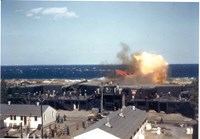
National Park Service
Existing national park sites, with their lighthouses and commanding ocean views, were armed to defend America's coast during World War II.
Following the attack on Hawaii's Pearl Harbor and the subsequent invasion of Alaska's Aleutian Islands large gun emplacements were added wherever authorities feared Imperial Japan was next to attack. As the war intensified San Francisco would be described as "a giant cannon aimed at the Pacific," likening the millions of tons of cargo and munitions coming out of the port to projectiles sent against the Japanese military forces. To protect the all-important entrance to the harbor, the Golden Gate and its famous bridge, the U.S. Army and Navy arrayed a vast network of coastal fortifications.
Older forts, some quietly sleeping since the Civil War, were re-awakened and re-armed to defend the homeland from far-reaching enemies.
- Boston Harbor Islands National Recreation Area
Controlled Submarine Mines in Boston Harbor
- Type: Article
- Locations: Boston Harbor Islands National Recreation Area

Facing advances in military technology and weaponry, the US looked to upgrade coastal defense systems around the turn of the 20th century. In many harbors, controlled submarine mines were installed. Learn about the role of the Boston Harbor Islands in monitoring the controlled submarine mine system during the World Wars.
- Aleutian Islands World War II National Historic Area
The Cultural Landscape of the Kiska Battlefield
- Cabrillo National Monument
The Guns of San Diego at Cabrillo National Monument
- Type: Article
- Locations: Cabrillo National Monument

Constructed during World War II, this concrete and steel fire control station was most important in Harbor Defenses of San Diego in that the battery commander of 16-inch-gun Battery Ashburn operated from the top level (BC3) directing the fire of his guns. The lower level (B1/3 S1/3) served as one of five base end stations for Ashburn.
- Golden Gate National Recreation Area
Fort Cronkhite: A Fortified Military Post in San Francisco
- Type: Article
- Locations: Golden Gate National Recreation Area

Fort Cronkhite, located just north of San Francisco, was a WWII Coast Artillery military post that was part of the Harbor Defenses of San Francisco. Fort Cronkhite served Battery Townsley, a 16-inch gun that, constructed with Battery Davis at Fort Funston, was designed to protect San Francisco and the Golden Gate straights from enemy attack.
- Type: Article
- Type: Article
- Locations: Acadia National Park, Cabrillo National Monument, Channel Islands National Park, Dry Tortugas National Park, Fort Pulaski National Monument, more »
- Olympic National Park
Coastal Defenses in Olympic National Park in World War II
- Type: Article

The wartime demand for manpower and the racial policy of the Roosevelt administration caused the Marine Corps to agree in February 1942 to accept African-American recruits for the first time since the Revolutionary War, when a few blacks had served in the Continental Marines. Many of these men defended America's coasts and served abroad in theaters of war.
- Type: Article
- Locations: Cape Hatteras National Seashore
- Offices: History, Maritime Heritage Program
- Fort Sumter and Fort Moultrie National Historical Park
Battery Jasper
Last updated: November 17, 2016






